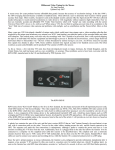Download July 2005 - East Valley Astronomy Club
Transcript
July 2005 The Voyager East Valley Astronomy Club Volume 19 Issue 7 From the Desk of the President Inside this issue: by Steven Aggas, 2005 EVAC President Clear skies… get it while it lasts. Monsoons will be here soon, and with them comes time to work on the telescope. Everyone knows that the amount of cloudy weather is proportional to the amount of money spent on the new astronomy related gadget. I don’t know if one causes the other or the other way around, but here in the valley there is usually a buying frenzy during July and August. If you’re building a new project or doing some modifications you think the rest of the club would enjoy hearing about, show us! Get some digital pictures or slides and bring ‘em to the meeting and I’ll pen you into the meeting program. drawing objects too! This is a very good technique for “seeing” more detail as your eye gets trained to see finer detail that you may not get in a quick glance in the eyepiece. As our speaker for the July General Assembly meeting, we will have A.J. Crayon, a member of both EVAC and the Saguaro Astronomy Club. AJ has drawn many objects he sees in the telescope and he will not only present some of them, but will have us try our skills at Join us for an interactive type meeting at the Southeast Regional Library (Gilbert Public Library) on Friday, July 15th at 7:30PM. The GPL is located at the Southeast corner of Greenfield and Guadalupe Roads. The Backyard Astronomer Double Your Pleasure by Bill Dellinges Drag yourself away from those Deep Sky Objects for a while and check out the six double stars listed below. Here are some of my favorite summer doubles. They range from a binocular pair to a quintuple multiple star. I hope you will enjoy viewing them as much as I have over the years. Data found within the brackets ([ ]) are components (AB), magnitudes, separation in arc seconds (“), and position angle in degrees (…340°, 90°, etc.). Albireo (Beta Cygni, ADS 12540) RA 19h 30.5m Dec +27o 58’ [A-B 3.1, 5.1, 34.4”, 54°] King of the summer doubles. Perhaps it’s most beautiful representative. Composed of a gold primary and blue secondary, this is an easy double to resolve. Even 10x70 binoculars begin to split it. For a time it was doubted Albireo was a true binary star because at a distance of 400 light years, a separation of 34.4” is equiva- lent to 55 solar systems! A very wide double indeed. Nevertheless, it’s currently accepted as a double star. I like to view it slightly out of focus to enhance the star’s color difference. Kuma (Nu Draconis, ADS 10628) RA 17h 32m Dec +55 10’ [A-B 4.9, 4.9, 62”, 312°] A double of exactly equal magnitudes - like headlights in your rear view (Continued on page 2) Lunar Map Pro Review 3 A Night of Feasting on Our Desert Sky 5 July Guest Speaker 5 Classified Ads 6 Meeting Site Maps 7 Calendar 8 Membership Application and Liability Waiver 9 NASA’s Space Place 11 If It’s Clear 12 NASA’s Space Eyes Focus on Deep Impact Target 13 Deep Sky Object of the Month 14 July Events: • Local Star Party at Boyce Thompson - July 2 • Beginners Lab in Gilbert July 8 • Public Star Party in Gilbert July 8 • Deep Sky Star Party at Vekol Road - July 9 • Monthly Meeting at Southeast Regional Library - July 15 The Backyard Astronomer (Continued from page 1) mirror. Easily split in hand held 8x50 binoculars. The pair is the dimmest star in the head of the dragon. Nu Scorpii (ADS 9951) RA 16h 12m Dec -19° 28’ [A-B 4.1, 5.2, 1.3”, 3°] [A-C 4.0, 6.5, 41.5”, 337°] [C-D 6.5, 7.8, 2.3” 39°] A double-double. 10x70 binoculars will split the two pairs. My 5” APO split the faint blue C-D pair at 74x. The 5” could not resolve the A-B 1.3” pair with 173x. My C14 at 230x shows A-B as figure 8 during moments of good seeing at my observatory next to the Superstition Mountains (where I have concluded the seeing is generally atrocious). I seem to recall my C-8 split A-B once at the Grand Canyon. Give it a shot. There aren’t that many “double-doubles” out there, and this is one of the best. That is, if you can split A-B! 31 Cygni (ADS 13554) (Omicron one Cygni) RA 20h 13m Dec +46° 44’ [A-B 3.8, 13.1, 36.6”, 331°] [A-C 3.8, 6.7, 107”, 173°] [A-D 3.8, 4.8, 337.5”, 322°] Double star observer James Mullaney calls this triple the “Patriotic Star” because the three have colors of red, white , and blue (Dec. 2000 S&T p.123). It takes a little sorting out to figure which three stars you want to identify. First of all, forget the 13.1 mag B star. It doesn’t play a role in this. The A star (31 Cygni, also called Omicron one) is the “red” one. The C star is the “blue” one. The D star is the white one. In a reversed field, A will be your central star. C will be at 5 o’clock. D will be near the 11 o’clock position. Now I must confess something: the D star, 30 Cygni, is an optical component, not a true member of this system even though it’s listed as such in Sky Catalog 2000 (vol. 2, p.132). Also, do not be confused by 32 Cygni (Omicron two), a little farther Page 2 north of the above mess. It sits on the northern edge of my Ranger’s 2.3 degree field if I put the colorful trio near the bottom of the field. Though D is an optical member, the A-B-C stars still make this system a triple. Did you get all that? So we have a most interesting quadruple star here! If summer monsoon evenings permit, give these guys a try. Warning: double star observing can be habit forming. By the way, I don’t see the colors as vividly as Mullaney does. Maybe younger eyes would help. Calculating True Field of View Xi Scorpii (ADS 9909) RA 16h 04’ Dec -11° 22’ When looking through a telescope, it is useful to know how wide or narrow a view you are seeing. This can help you compare what you are seeing to your star chart or atlas. [A-B 4.8, 5.1, 0.7”, 341°] [A-C 4.8, 7.3, 7.5”, 48°] This beautiful quintuple star lies way, wayyy up in northern Scorpius. In the same field of this “triple” you can see Struve 2725 (ADS 14270) [AB 7.0, 8.0, 5.8”, 358°] which is considered a member of the group thus making a total of five stars. My 5” at 173x splits the A-C and Struve pair but the tough A-B (0.7”) pair wouldn’t yield to the aperture - challenged refractor. My C14 failed recently to split AB at 98x, 230x, and 279x. The good news? A-B is widening from its 1997 minimum. So any night now, you might be able to crack the A-B nut. Rho Ophiuchi (ADS 10049) RA 16h 25m 35s Dec -23° 27’ [A-B 5.0, 5.7, 3.1”, 340°] [A-C 5.0, 7.3, 151”, 360°] [A-D 5.0, 7.0, 156.3”, 253°] This is part of that well known color photo showing the Rho Ophiuchi bright and dark nebulae above Antares. Rho is lighting up the top most blotch of gas which seems to also have a vertical split through it. Visually you’ll see none of that. But even an 8x50 binocular or finder will separate the A-C-D components. That’s what brought this star to my attention. Then I learned all of these guys were part of a multiple star. I was later able to split the A-B pair (3.1”) with a TV85 at 75x. Stars travel westward through the sky at the rate of one revolution every 23 hours 56 minutes (86,164 seconds). Stars near the celestial equator (declination near zero) move most rapidly across the sky. Stars further from the equator, move more slowly. The adjustment factor is the cosine of the star’s declination. These facts can be used to calculate the field of view (angle of view) through any combination of eyepiece and telescope. It is known as the drift method. * Select any bright star which is near (within about 20°) the celestial equator. * Look up the declination of the star in an appropriate table. * Observe the star through the eyepiece/telescope combination you want to measure. * Turn off the motor drive. The star will drift due west (on the celestial sphere). * Adjust the declination of the telescope so that the star passes right through the center of the eyepiece (the widest part). * Adjust the right-ascension of the telescope so the star is just out of (Continued on page 12) The Voyager Lunar Map Pro version 3.0 Software Review by Peter Argenziano Lunar Map Pro, now in its fourth release, is described by its publisher as “the most advanced, highest resolution lunar application ever developed for Windows.” Most users will, no doubt, agree with this assessment even though this description seems inadequate after using the program within the context of a lunar observing campaign. The software ships on a single CDROM housed in a plastic case of the type used for DVD movies. No printed documentation is supplied; however a Quick Start Guide and a User’s Manual are contained on the disc. Both documents, in PDF format, are accessible from within the application. Adobe Acrobat Reader v5.05 is also furnished on the CD. Documentation is also available on the RITI website. While Lunar Map Pro provides sophisticated features and functionality that will satisfy the most experienced lunar observers, it does not do so at the expense of those new to viewing our closest celestial neighbor. The software installation is quick and easy. The user is prompted for the desired installation directory, the program group in which to locate the application’s icons and the level of install - ranging from a compact 110 MB to a complete 370 MB. Given the cost of hard drive space these days and the nature of this application; I don’t see any reason not to perform a complete install. A desktop shortcut is also created. RITI employs copy protection that requires the user to insert the CD each time the application is launched. The disc can be removed once the program starts. RITI grants the user permission to install the software on as many PCs as desired. An optional procedure can be employed to obtain a license string that negates having to insert the CD, if so desired. Once the installation is finished and the application is launched, the CD Volume 19 Issue 7 can be removed from the drive (if a complete install was performed). When the program opens, the user is greeted by a raster map of the lunar nearside (created from NASA Clementine data) with orangecolored overlaying latitude and longitude lines (zero latitude and longitude lines are blue). The grid can be toggled on or off, and it dynamically adjusts to the magnification level of the map. Also displayed on the initial screen is a smaller navigational window. The content of this window is a small vector map of the lunar disc, with an inset rectangle indicating the area being displayed on the main map – a very handy feature that can be dragged anywhere on the screen, minimized or closed. It is updated whenever the main map changes. Navigational tools can be used on either map. Like most astronomy software, Lunar Map Pro retains the general structure and appearance of any Windows application. There are menu headings horizontally placed above a toolbar at the top of the screen and a status bar along the bottom. Both the toolbar and status bar can be toggled on and off. The toolbar is pre-configured with what the publisher considers to be the most used features, but it is not customizable. The menu headings include: File, View, Zoom, Pan, Help, Tools and Lunar, with appropriate sub-menus below. The status bar displays the latitude and longitude relative to your cursor position on the map in addition to the scale of the map. The program boasts an impressive database of 8,169 named features including 1,561 primary craters; 5,863 associated lettered craters; 26 large plains; 35 small plains; 20 crater chains; 158 domes or volcanic peaks; 40 ridges; 34 mountain peaks; 19 mountain ranges; 11 capes; 269 fissures; 9 scarps; 33 valleys; and 79 features named by Apollo astronauts. The main lunar map is corrected for libration, ensuring an accurate depiction of the Moon. The default display is North Up, matching naked-eye or binocular views. It is also configurable as North Up Reversed (SCT or MCT view), South Up (Newtonian) or South Up Reversed (southern hemisphere SCT) – ensuring every lunar observer is accommodated with a display matching that of their telescope. The map can be further configured to show vector feature outlines, with or without the raster image. This is especially useful in identifying difficult features both on-screen and on the printed charts. Mare can also be displayed using vector polygons. And if that wasn’t enough, you can also display color-coded geological data classifying features by type, age and system. This flexibility is sure to provide a map appropriate to most any observational activity. Raster map of Atlas & Hercules Vector outline map of Atlas & Hercules In addition to the searching tool, features can be identified by hovering over them with the cursor. Once identified a right-click provides biographical data. (Continued on page 4) Page 3 Lunar Map Pro version 3.0 (Continued from page 3) The File menu provides the functionality to redraw the map on-screen, as well as to write the map to a file or send it straight to the printer. In the View menu, the user can toggle the toolbar, status bar and compass. The compass is a very handy feature when working with magnified maps, allowing the user to keep their bearings. The new 3D feature is also activated from within this menu. This feature is based on lunar radar data combined with a GIS platform to render some very interesting views. 3D view of Theophilus area The user has control over point-ofview, magnification and orientation in 3D views. The Zoom menu provides control over map magnification. Personally, I find it easier to use the toolbar for this activity. From here you can zoom in or out in 50% increments and quickly return to the full lunar disc map. You can also enable zooming by way of a rectangle dragged across the map with your cursor – this being the most useful feature in the menu for my use. A scaling tool allows you to precisely scale your map, if your project calls for such precision. The Help menu provides the expected functionality plus some unexpected features: a glossary, a list of label abbreviations, a lunar fact sheet, a legend for the color-coded geology markings, and a table for locating the objects in Charles Woods’ Lunar 100 observing list. The Pan menu is home to navigational commands such as stepping (in 25% increments) to the north, south, Page 4 east or west. You can also enable the dragging of the map. The mouse can be used to center a clicked-on feature. And a feature can be centered by entering its coordinates. Within the Tool menu the user can access the labeling feature. While this is quite extensive and customizable to a great degree, I would like to see additional flexibility allowing users to apply whatever level of labeling they require on maps or saved files. The labeling is executed by entire groups of features, which can’t be edited. So, if you check the Craters box, all craters visible in your map will be labeled. This can be quite useful, but there will also be projects which just require the ability to selectively label features. Font size and color can be adjusted to suit the intended use of the map. The Surveyor tool is accessed from within this menu, and it allows the user to make accurate lunar measurements. While most data regarding individual features is readily available, this tool allows for measurements limited only by your imagination. The geographic information system (GIS) upon which Lunar Map Pro is built takes into consideration the difference between the flat, displayed image and the actual curvature of the Moon. The result is a surprisingly accurate measurement system. You can measure between any number of points, so curved or irregular shapes aren’t excluded. The user guide indicates that an enhanced level of accuracy is obtained when using higher map magnifications. A useful tool that’s fun to use too! I found that accuracy can be further increased by turning on the vector outlines in the map. A Night View tool is available, but I don’t find it to be particularly useful. It allows the user to dim the screen, while keeping the toolbar buttons at full brightness. Since dark adaptation isn’t really necessary when observing Luna, at least not for me, I don’t see a need for such a feature. If I want to dim the screen, I normally just use that functionality provided by my laptop. Maybe you will find it useful. The Resource Viewer tool provides a link to tons of online lunar information, right from within the application. A very nice feature when you are using the program indoors, or if you are so lucky as to have an internet connection at the telescope. The Lunar menu is home to some of the most useful features in the program. From here you can control the mapping properties, the time, phases, search for specific features, toggle the grid, adjust the field of view, create an ephemeris, display landing sites and change your point of view. The Time, Phases and Ephemeris features all work together dynamically. The time can be either your local time or universal time. Within the Phases tool, the opacity of the portion of the lunar disc in darkness can be varied, thereby allowing the user to still discern features beyond the terminator. When the Time tool is open, the map is not updated automatically – the user must click a button labeled Current to update the map. The Phase Manager shows one lunation, and is an excellent tool to help the user understand the lunar cycle graphically. It can also be employed to manually adjust the map to lunar cycles other than the current lunation. This is very useful for planning purposes, or to review past observing sessions… so long as the dates are between January 1, 1970 and December 31, 2100. Working with the Ephemeris tool requires that the user input the latitude and longitude of their observing site. The Field of View tool is one of my favorite features of the entire program. This nifty tool allows for the creation of custom maps – displayed or printed – that correspond to the view through your telescope. Naturally, you have to first configure the application with the focal lengths of (Continued on page 15) The Voyager July Guest Speaker: AJ Crayon From the bayous of Louisiana to the deserts of central Arizona, our guest speaker for July has spent many an hour at the eyepiece. AJ Crayon will bring his wit, humor and venerable observing expertise together in a presentation on techniques you can use to sketch the objects you are observing. The club will provide pencil and paper so that you may practice the techniques that AJ discusses. No previous artistic experience is required. If you plan on participating, please bring along a hard, flat surface upon which you may write (a book, notebook or clipboard would work well). Sketching at the eyepiece is a great way to improve your observational skills. A Night of Feasting On Our Desert Sky by Pedro Jane’ Friday afternoon, June 6. A welcome call from my friend Sam Herchak. "Would you like to go observing tonight?" 45 minutes later, I had my 16" Dob reflector, my camcorder and tripod and some homemade garlic salsa/chips (good bug repellent) all loaded in my jeep. A stop to pick up Sam and we h3eaded for the Picketpost trailhead site. With my scope and his laptop, we were ready to dine. The appetizer was an Iridium flare which I videotaped and hope to show at the meeting. These are predicted on an excellent website- heavensabove.com. Most man-made objects paths are found here by entering your position and time. The flare reached -8 mag. Our next stop was at the far end of the table. Quasar 3C 273 mag 13 in Virgo. This is 3 billion light-years away and is the most distant object for amateurs. It is a very remote galaxy with an energetic nucleus. It appears as a faint star. We then located Pluto which will be at opposition June 13. Sam's laptop in one hand while peering thru the eyepiece makes it much easier to spot. Two nights observing would also help to see the change of it's position. My favorite object was next. M13 is the dazzling salad of this feast but Volume 19 Issue 7 tonite was special. The conditions allowed two crackers with our saladNGC6207(mag12) and IC4617 (mag16). Then a meteor accented the whole view. Cepheus contains a treat often overlooked. A tasty pairing of an open cluster, NGC6939(mag8) and a galaxy NGC6946(mag9). After this palate cleansing view, it's time for the main course. Comet Temple 1. It's now at mag 10 but may soon reach mag 5. On July 3rd at 11:00 P.M. planetary scientist H. Jay Melosh and his pals are going to fire an 820 lb. copper bullet at this comet. It will strike the surface at 23,000 mph. I'll be watching this one! On this night, the comet was near NGC4845(mag4) and NGC4900(mag12). Comets and galaxies together oh boy! How's about dessert? A nice rectangular cluster NGC6802(mag9)and the baked alaska of the sky NGC6826(mag10). The latter is a blinking planetary nebula I had never seen before. Some believe the blinking is an optical illusion but a thrill just the same. After a few Messier mints we were ready to leave. The night had become quite cold so we packed up and headed home. You Too can have a feast night like this. Just remember to pick up Sam on your way out. New Moon on July 6 at 05:02 First Quarter Moon on July 14 at 08:20 Full Moon on July 21 at 04:00 Last Quarter Moon on July 27 at 20:19 Page 5 Classified Advertisements Meade ETX-70 with Meade 9mm and 25mm eyepieces, Autostar, and flex focus. $150.00 Damion Pauksta (602) 240-5421 [email protected] NexStar 11 GPS Carbon fiber model purchased from Astronomics late 2003, unused due to illness. Included with all standard accessories are Feathertouch focuser, 2” AP visual back, JMI Wheely Bars with extra-large wheels and complete Celestron ‘gift’ set of eyepieces and filters in case. Cost well over $3600 -- will sell for $2000 firm. Prefer local sale. Norm Rubenstein (623) 322-6464 Meade Pictor 416XT CCD All components, filters, manuals, adaptors, autoguider and CCD camera are still in their original factory sealed condition and plastic wrap. Why? Well, the Pictor and it’s software are intended for use with a Windows computer and I never got around to buying a Windows laptop -- sounds silly -- but that’s the fact. The Pictor 416XT uses the Kodak KAF-0400 CCD chip with the extended blue response. As a CCD camera, it’s considered among the best available under $5000! The autoguider and camera will connect directly to the control panel jacks of Meade LX50, LX90 (APM) and LX200 telescopes (and probably others with similar electronic relay autoguider ports). See a current ad for this unit at: http://telescopes.net/ccd__cameras.html The Pictor 416XT normally sells for about $2000 (I paid $2035 with tax), but I’ll sell it for $1299 (brand new!!). John Matthews (602) 952-9808 [email protected] 16” f4.5 Meade Starfinder with Equatorial Mount Optics remounted into a new tube, built by Pierre Schwarr with a JMI focuser. Includes 7, 12.5, 17, 20, and 32mm eyepieces plus 2.8 Klee Barlow, laser collimator and an Olympus OM1 camera. Many extras! Call or e-mail me for a list. I have $5200 invested in this telescope package, but will sell for $2000 Dave Rainey 602-980-0582 [email protected] Wanted 2" TV Everbright or equivalent quality diagonal with compression clamp. Must be in excellent condition. Contact Silvio 480-926-8529 [email protected] Only non-commercial advertisements for astronomical equipment will be accepted from current EVAC members. Ads will be published as space permits and may be edited. Ads should consist of a brief text description and must include a current member name and phone number. You may include your email address if you wish. Ads will be run until canceled or until they have appeared in three issues of the newsletter (whichever occurs first). Ads should be emailed to: [email protected] Support your local telescope dealer! Page 6 The Voyager The monthly general meeting is your chance to find out what other club members are up to, learn about upcoming club events and listen to presentations by professional and well-known amateur astronomers. Our meetings are held on the third Friday of each month, at the Southeast Regional Library in Gilbert. The library is located at 775 N. Greenfield Rd., on the southeast corner of Greenfield and Guadalupe Roads. Meetings begin at 7:30pm. Visitors are always welcome! 2005 Meeting Dates July 15 August 20 September 16 October 21 November 18 Southeast Regional Library 775 N. Greenfield Road Gilbert, AZ 85234 December 16 All are welcome to attend the pre-meeting dinner at 5:30 PM. We meet at Old Country Buffet, located at 1855 S. Stapley Drive in Mesa. The restaurant is in the plaza on the northeast corner of Stapley and Baseline Roads, (near the Walmart Supercenter) just south of US 60. Old Country Buffet 1855 S. Stapley Drive in Mesa Volume 19 Issue 7 Page 7 Schedule of Events July 2005 Sun Mon Tue Wed Thu Fri Sat 1 2 3 4 5 6 7 8 9 10 11 12 13 14 15 16 17 18 19 20 21 22 23 24 25 26 27 28 29 30 • July 2 - Local Star Party at Boyce Thompson Arboretum • July 8 - Beginners Lab at Riparian Institute in Gilbert (6:30 PM) • July 8 - Public Star Party at Riparian Institute in Gilbert • July 9 - Deep Sky Star Party at Vekol Road • July 15 - July General Meeting at Southeast Regional Library in Gilbert 31 Minutes of June General Meeting Meeting date: Tuesday, June 14, 2005 Meeting location: Southeast Regional Library in Gilbert The meeting was opened by President Steven Aggas. The club officers stood and introduced themselves. John Dobson inquired if there were any non-officer members present. Treasurer Wayne Thomas reported the income and disbursements for the month. He also reported that membership has grown to 211 members. Events Coordinator Randy Peterson announced the following astronomical events: June 25th – Conjunction of three planets (Venus, Mercury and Saturn). The club will offer a public viewing of this event at the Riparian Preserve from 8 until about 9 PM. July 3rd – The Deep Impact mission concludes a six-month, 268 million mile voyage to comet Tempel 1 by sending a projectile crashing into the cosmic traveler. July 8th – Beginners Lab and Public Star Party at the Riparian Preserve, with the lab beginning at 6:30 PM. Plans are being made to purchase new club shirts. All interested parties are asked to contact Randy. All shirts are to be prepaid to ensure delivery. Peter Argenziano presented Joe Goss with two plaques for his completion of the Planetary Nebulae and Finest NGC observing programs. Congratulations Joe Goss! Steven Aggas showed slides of his newest observatory, a roll back shed recently built in Overgaard. Pictures of the progress to near completion gave a good idea of the construction details of this project. Pedro Jane’ offered a quick video of an Iridium flare from the overhead passing of a satellite. Recognition goes to Joe Orman for two new photo publications. The first is in the French magazine “Attraction Physique” of the Hale-Bopp comet. The second photo will appear in a new textbook, “Discovering the Universe” of the Moon – Venus conjunction. The next meeting will be Friday July 15th at the Gilbert Southeast Regional Library. A. J. Crayon will present techniques for drawing while observing. All in attendance are urged to participate, as pencils and paper will be provided. The meeting broke for a short intermission and refreshments. The featured speaker for the meeting was John Dobson (of Sidewalk Astronomer fame) who explained, often by short funny stories, his perceived fallacies of the Big Bang Theory. Many in the audience would have kept listening to him all night given the opportunity. The meeting was regretfully closed with an ovation fully deserved. Page 8 The Voyager East Valley Astronomy Club -- Membership Form Please complete this form and return it to the club Treasurer at the next meeting or mail it to EVAC, PO Box 2202, Mesa, Az, 85214-2202. Please include a check or money order made payable to EVAC for the appropriate amount. IMPORTANT: All memberships expire on December 31 of each year. Select one of the following: New Member Renewal Change of Address New Member Dues (select according to the month you are joining the club): $20.00 January through March $15.00 April through June $10.00 July through September $25.00 October through December Includes dues for the following year Renewal (current members only): Magazine Subscriptions (include renewal notices): $20.00 January - December $29.00 Astronomy $33.00 Sky & Telescope Name Badges: $10.00 Each (including postage) Total amount enclosed: Quantity: Name to imprint: Please make check or money order payable to EVAC Payment was remitted separately using PayPal Payment was remitted separately using my financial institution’s online bill payment feature Name: Phone: Address: Email: Publish email address on website City, State, Zip: URL: How would you like to receive your monthly newsletter? (choose one option): US Mail Electronic delivery (PDF) Areas of Interest (check all that apply): Please describe your astronomy equipment: General Observing Cosmology Lunar Observing Telescope Making Planetary Observing Astrophotography Deep Sky Observing Other Would you be interested in attending a beginner’s workshop? Yes No How did you discover East Valley Astronomy Club? PO Box 2202 Mesa, AZ 85214-2202 www.eastvalleyastronomy.org Volume 19 Issue 7 Page 9 Liability Release Form In consideration of attending any publicized Star Party hosted by the East Valley Astronomy Club (hereinafter referred to as “EVAC”) I hereby affirm that my family and I agree to hold EVAC harmless from any claims, liabilities, losses, demands, causes of action, suits and expenses (including attorney fees), which may directly or indirectly be connected to EVAC and/or my presence on the premises of any EVAC Star Party and related areas. I further agree to indemnify any party indicated above should such party suffer any claims, liabilities, losses, demands, causes of action, suits and expenses (including attorney fees), caused directly or indirectly by my negligent or intentional acts, or failure to act, or if such acts or failures to act are directly or indirectly caused by any person in my family or associates while participating in an EVAC Star Party. My signature upon this form also indicates agreement and acceptance on behalf of all minor children (under 18 years of age) under my care in attendance. EVAC only recognizes those who are members or invitees and who also have a signed Liability Release Form on file as participants at an EVAC Star Party. Please print name here Date Please sign name here PO Box 2202 Mesa, AZ 85214-2202 www.eastvalleyastronomy.org Page 10 The Voyager Moving a Mountain of a Dish by Patrick L. Barry Your first reaction: “That’s impossible!” How on earth could someone simply pick up one of NASA’s giant Deep Space Network (DSN) antennas—a colossal steel dish 12 stories high and 112 feet across that weighs more than 800,000 pounds— move it about 80 yards, and delicately set it down again? Yet that's exactly what NASA engineers recently did. One of the DSN dishes near Madrid, Spain, needed to be moved to a new pad. And it had to be done gingerly; the dish is a sensitive scientific instrument full of delicate electronics. Banging it around would not do. gradually raised the entire dish to a height of about 4.5 feet. Then Mammoet engineers positioned specialized crawlers under each corner. Each crawler looks like a mix between a flatbed trailer and a centipede: a flat, load-bearing surface supported by 24 wheels on 12 independently rotating axes, giving each crawler a maximum load of 194 tons! Placement on the new pad had to be perfect, and the alignment was tested with a laser. To position the dish, believe it or not, Mammoet engineers simply followed a length of string tied to the pad’s center pivot where the dish was gently lowered. It worked. So much for “impossible.” One engineer took the master joystick and steered the whole package in its slow crawl to the new pad, never exceeding the glacial speed of 3 feet per minute. The four crawlers automatically stayed aligned with each other, and their independently suspended wheels compensated for unevenness in the ground. Find out more about the DSN at http:// deepspace.jpl.nasa.gov/dsn/ . Kids can learn about the amazing DSN antennas and make their own “Super Sound Cone” at The Space Place, http:// spaceplace.nasa.gov/en/kids/ tmodact.shtml. “It was a heck of a challenge,” says Benjamin Saldua, the structural engineer at JPL who was in charge of the move. “But thanks to some very careful planning, we pulled it off without a problem!” The Deep Space Network enables NASA to communicate with probes exploring the solar system. Because Earth is constantly rotating, a single antenna on the ground can communicate with a probe for only part of the day, when the probe is overhead. By placing large dishes at three locations around the planet—Madrid, California, and Australia—NASA can maintain contact with spacecraft around the clock. To move the Madrid dish, NASA called in a company from the Netherlands named Mammoet, which specializes in moving massive objects. (Mammoet is the Dutch word for “mammoth.”) On a clear day (bad weather might blow the dish over!), they began to slowly lift the dish. Hydraulic jacks at all four corners Volume 19 Issue 7 Giant Deep Space Network antenna in Madrid is moved using four 12-axle, 24wheel crawlers. Page 11 If it’s Clear... on it. At 9:14 Io's shadow leaves. At 10:09 Europa's shadow falls on it. 8 minutes later Europa moves from in front of the planet. July 2005 On Sunday, July 17, at 8:33 PM, you can see the Moon cover Antares. The star reappears at 9:12 PM. Binoculars should be good enough to watch the disappearance on the dark limb of the Moon. You might want a small (3 inch) telescope to watch the reappearance on the bright limb. by Fulton Wright, Jr. Prescott Astronomy Club Shamelessly stolen information from Sky & Telescope magazine, Astronomy magazine, and anywhere else I can find info. When gauging distances, remember that the Moon is 1/2 a degree or 30 arc minutes in diameter. All times are Mountain Standard Time unless otherwise noted. On Sunday, July 3 at 10:52 PM, you might be able to see the results of a space probe hitting a comet. If all goes according to plan (and that is a big if), Arizona will be well placed to observe the event, and the comet might brighten from mag 10 to mag 6. See Sky and Telescope, June 2005, p. 40, 67, & 70; or Astronomy magazine, June 2005, p. 68. for details. Search for "Deep Impact" on the web for even more information and last minute updates just before the event. On Tuesday, July 5, it is new Moon so you have dark skies for all night observing if you like. On Friday, July 8, about 8:30 PM, you can see three solar system objects near each other. With your unaided eye or binoculars look 10 degrees above the west horizon for the thin, crescent Moon; brilliant Venus below it; and faint Mercury down and to the left, all within a binocular's field of view. On Monday, July 11, you can see some events with Jupiter's moons. At about 8:30 PM you should be able to find the planet in the twilight with Europa in front of it and Io's shadow On Monday, July 18, you can watch several events with Jupiter's moons. Here is the schedule: 8:59 PM Io's shadow falls on Jupiter (Io is already in front of Jupiter) 9:58 PM Io moves from in front of Jupiter 10:16 PM Europa moves in front of Jupiter On Wednesday, July 20, at 7:40 PM, the full Moon rises. Forget the faint fuzzes tonight and check out the rays and other albedo features on the Moon. For a few days around this date it will be an especially good time to look at the northern edge of the Moon which is tilted toward us by libration. Calculating True Field of View (Continued from page 2) view on the east edge. * Let the star drift into view. * Begin timing when the star first appears and stop timing when the star disappears off the other (west) edge of the field of view. * Calculate the elapsed time (drift time). * Repeat this measurement 2 more times, comparing your results to ensure no errors have been made. Find the average time for the 3 measurements. Convert the average time to an angle of view as follows: Page 12 (drift time) x cos(star dec) x 360° 120 x 0.9588 x 360° 86,164 seconds 86,164 seconds Be sure to use the same units for all like measurements (usually seconds for time, degrees for angles). For example: Aldebaran (brightest star in Taurus) has a declination of +16°30" cos(16°30") = 0.9588 Three drift timings: 1. 121 seconds 2. 119 seconds 3. 120 seconds Average time is 120 seconds = 0.481° or 28’ 51” For this particular eyepiece/telescope combination, the true field of view is almost one-half degree. This is about the size of a full Moon. Every combination of eyepiece and telescope will be different, but in general: * The longer the focal length of the eyepiece, the larger the field-of-view (with the same telescope). * The longer the focal length of the telescope, the smaller the field of view (with the same eyepiece). The Voyager NASA'S Space Eyes Focus on Deep Impact Target On July 4, NASA's Deep Impact spacecraft will attempt an extraordinarily daring encounter with the farflung comet Tempel 1, which is hurtling through space at tens of thousands of miles per hour. As if that is not challenging enough, the comet's size, shape and other characteristics are not entirely known. Two of NASA's eyes in the sky, the Spitzer and Hubble Space Telescopes, helped scientists prepare for the comet encounter. From their orbits high above Earth, the telescopes watched Tempel 1 in early 2004. Together they came up with the best estimates of the comet's size, shape, reflectivity and rotation rate. The data may help Deep Impact snap pictures of the dramatic rendezvous and increase the probability of making contact with the comet. "Even tiny adjustments to our model of Tempel 1 are crucial to hitting the target and setting camera exposure times," said Dr. Carey Lisse, Johns Hopkins University Applied Physics Laboratory, Laurel, Md. Lisse is team leader for the Tempel 1 Spitzer studies. Previous observations of Tempel 1 taken with ground-based telescopes indicated the comet is dark and oblong, with a width of a few miles, or kilometers. Spitzer and Hubble refined these measurements, revealing a matte black comet approximately 14 by 4 kilometers (8.7 by 2.5 miles), or roughly one-half the size of Manhattan. "Spitzer was crucial in pinning down the comet's size," said Dr. Michael A'Hearn of the University of Maryland, College Park. He is principal investigator for Deep Impact and the Hubble observations. "We'll know exactly what it looks like when we get there." The Deep Impact spacecraft was launched on Jan. 12, 2005. Its misVolume 19 Issue 7 sion is to study the primordial soup of our solar system, which is sealed away inside comets. On July 3, as it approaches Tempel 1, the spacecraft will separate into two parts. The impactor will attempt the tricky task of placing itself in the path of the speeding snowball, while the second part, the flyby spacecraft, swings around for a ringside view. After the impactor is released, its specialized software will steer it toward the sunlit portion of Tempel 1's nucleus. To program the software, mission planners at NASA's Jet Propulsion Laboratory, Pasadena, Calif., needed to know the size and reflectivity of Tempel 1's surface. Since its surface can't be observed directly from Earth, scientists turned to Spitzer's infrared eyes to measure its size. least 30 telescopes around the world, including Spitzer, Hubble and the Chandra X-ray Observatory, will be watching the dramatic impact. By analyzing the material blown out of the interior of the comet, this global network of telescopes will assemble a list of the raw ingredients that went into making the planets in our solar system. JPL manages the Deep Impact mission for NASA. For information about NASA and the Deep Impact mission on the Web, visit the following websites: http://www.nasa.gov/home/index.htm l http://www.spitzer.caltech.edu/spitze r http://hubblesite.org/news/ http://deepimpact.jpl.nasa.gov/ When viewing a comet in visible light from very far away, only reflected sunlight can be seen, so a big, dark comet can look the same as a highly reflective, small comet. In infrared light, a comet's radiated heat is measured, providing a direct look at its size. Once the size of Tempel 1 was known, scientists could calculate surface reflectivity using a combination of Spitzer and Hubble data. They found Tempel 1 reflects only four percent of the sunlight that falls on it. "Knowing the reflectivity also tells us how to set up our cameras," Lisse said. "Like photographers, it's important for us to know our subject before the shoot." Tempel 1's shape and two-day rotation rate were derived from longterm observations made by various telescopes, including Hubble, Spitzer and the University of Hawaii's 2.2meter telescope at Mauna Kea. The 2006 Astronomy calendars have been ordered and will soon be available for purchase! In addition to the flyby spacecraft, at Page 13 NGC 6818 (Little Gem) Distance: 7,300 ly Deep Sky Object of the Month Planetary Nebula in Sagittarius Size: 40” Dec -14° 09’ 11” Magnitude of central star: 15.0 Magnitude: 9.9 RA 19h 43m 57.8s The Voyager Page 14 Lunar Map Pro version 3.0 (Continued from page 4) your telescopes, and with the focal lengths and apparent field of view for your oculars. A very powerful observational tool is at your fingers when this tool is combined with phase display and proper map orientation. The Feature Finder makes easy work of locating any feature in Lunar Map Pro’s vast database. Once the feature is located you can employ other observational tools such as the sunrise and sunset gazetteer. A click of the mouse lets you know the dates and times for the next sunrise and sunset for that feature – what a useful planning feature that is! Another useful feature of this tool is the ability to link your own images, sketches and observing notes to any feature in the database. How cool is that? Atlas and Hercules in a FOV map specific to an Intes MK66 and Barlowed 7mm UO HD Orthoscopic. The Point of View tool is not about personal opinion… rather it allows you to change your view of the Moon by aligning yourself at different points in space. Another one of those features that is fun to play with. And yet another useful feature of this tool is to selectively apply labels. Unlike the labeling feature discussed earlier, this is where you have almost complete labeling control. Almost? Yes, you are limited in where the application places the label. It seems that the label has to touch the feature, while it would be nice to be able to drag the label into just the right position. The 3D Viewer tool is new in this version of the software. It allows the user to create maps which depict the lunar topography. The adjustable parameters include point of view, magnification, orientation, relief exaggeration and visual appearance. Two resolution levels can be employed, with the higher level using a display twice the size of the lower resolution, with twice the data. The Point of View is adjustable in 25% increments to the north, south, east or west. You can zoom in or out by a factor of two. Rotation is adjustable in 10° increments up, down, left or right. The Relief Exaggeration applies a multiplier to all surface elevations, and thereby makes it easier to see subtle features. The Visual Appearance can either be photo-realistic or in the form of a wire mesh. Alternating between the two allows the user to fully comprehend the topography of the feature under study. I started using Lunar Map Pro with version 2.0, and just recently upgraded to version 3.0. I am constantly seeking to enhance my lunar observation skills, and this program has greatly facilitated that endeavor. I would unequivocally recommend this program to anyone with a serious interest in lunar studies, whether the studies involve visual observation, lunar photography, or just armchair observing. Coming in August… our guest speaker will be Dr. Jeff Hester, from the Physics and Astronomy department at ASU. Dr. Hester’s topic will be "Born Among Giants," which discusses the evidence that the Sun formed near one or more massive, luminous stars, and the ways that the presence of nearby massive stars shaped our Solar System. Star Party Disclaimer The East Valley Astronomy Club (EVAC) is not responsible for the property or liability of any star party participant, nor will the club be held liable for their actions or possessions. EVAC is not responsible for any vehicular damage, theft, or mechanical difficulties that may occur while attending a star party. EVAC strongly recommends adherence to the doctrine of 'safety in numbers' when it comes to remote observing sites. In the interest of safety it is recommended that you don't go to remote sites alone and that someone knows where you have gone each time you go out observing. Volume 19 Issue 7 Page 15 The Voyager is published monthly by the East Valley Astronomy Club and made available electronically (PDF) the first week of the month. Printed copies are available at the monthly meeting. Please send your contributions, tips, suggestions and comments to the Editor (Peter Argenziano) at: [email protected] Contributions may be edited. President: Steven Aggas Vice President: Howard Israel Secretary: Peri Cline Treasurer: Wayne Thomas Event Coordinators: Gwen Grace & Randy Peterson Properties Director: Dave Williams Newsletter Editor: Peter Argenziano Webmaster: Marty Pieczonka www.eastvalleyastronomy.org Keep Looking Up! East Valley Astronomy Club PO Box 2202 Mesa, AZ 85214-2202 Board of Directors: Joe Goss, Jim Fitzpatrick, John Holmquist, Chuck Crawford & Dave Shafer
















![Eko 2030 Installation instructions [EN] A:XL09 Installation](http://vs1.manualzilla.com/store/data/005791571_1-4177cf65afac91638228769661e5ee6f-150x150.png)

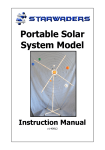
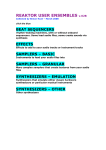
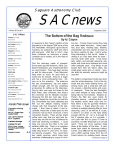

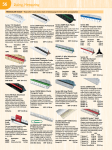
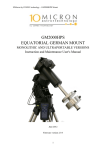
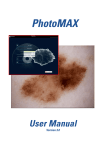

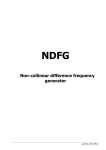



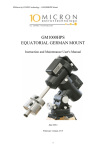


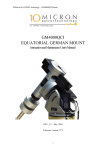
![eko 4000 series installation manual A [EN]:XL03](http://vs1.manualzilla.com/store/data/006898434_1-46c26fba35bf59407139a85b77984d70-150x150.png)

